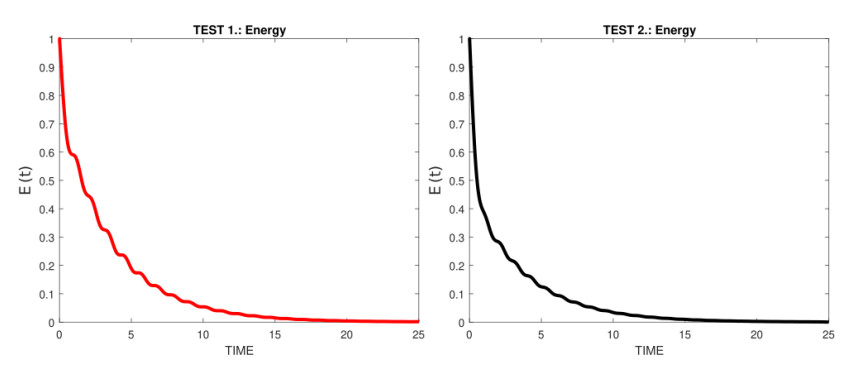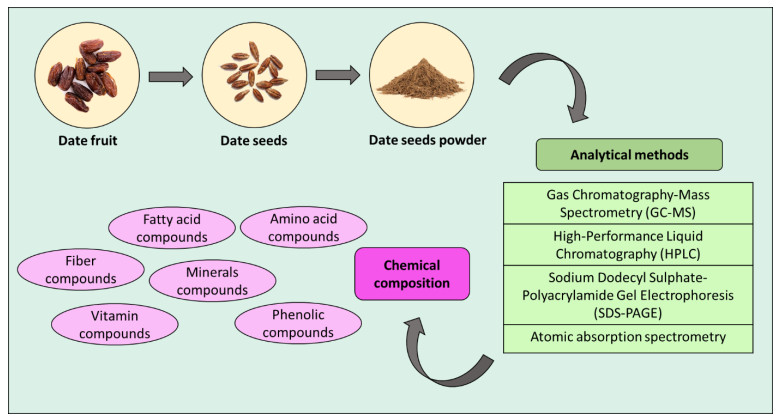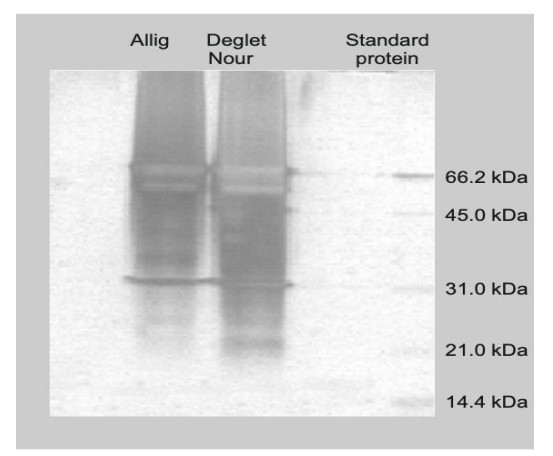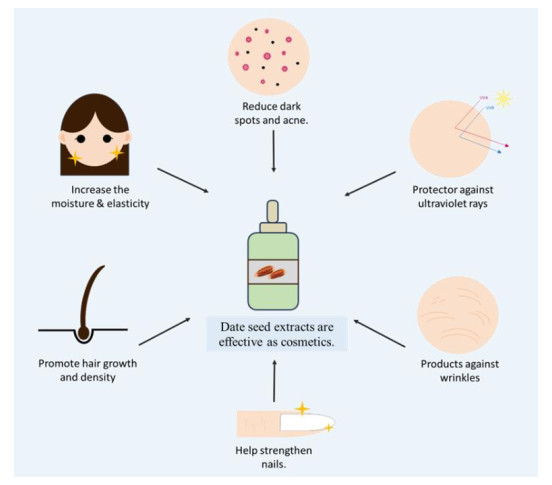1.
Introduction
The importance of partial differential equations in comprehending and explaining physical interpretation of problems that arise in numerous fields and engineering motivates many researchers to analyze and investigate the existence and stability of their solutions. Hyperbolic partial differential equations are the most interesting kind of partial differential equations, since they are utilized to simulate a wide and important collection of phenomena, such as aerodynamic flows, fluid and contaminant flows through porous media, atmospheric flows, and so on. Of the higher order hyperbolic equations, the wave equation is the most obvious. Klein-Gordon, Telegraph, sine-Gordon, Van der Pol, dissipative nonlinear wave and others are well-known hyperbolic equations that are important in the fields of wave propagation [1], random walk theory [2], signal analysis [3], relativistic quantum mechanics, dislocations in crystals and field theory [4], quantum field theory, solid-state physics, nonlinear optics [5], mathematical physics [6], solitons and condensed matter physics [7], interaction of solitons in collision-less plasma [8], fluxions propagation in Josephson junctions between two superconductors [9], motion of a rigid pendulum coupled to a stretched wire [10], material sciences [11] and non-uniform transmission lines [12] are some of the topics covered. For more related results, we refer to [13,14,15]. There is a vast range of publications for numerical solutions of hyperbolic partial differential equations, such as the one in [16,17,18,19,20,21]. In recent years, great efforts have been devoted to study problems with nonlinear dampings and source terms, and several existence, decay and blow up results have been established. Georgiev and Todorova [22] considered the following nonlinear problem
where the damping term h(ut)=|ut|m−2ut and the source term F(u)=|u|q−2u are localized on the domain and established global existence when q≤m and a blow up result when q>m. This work was improved by Levine and Serrin [23] to the case of negative energy and m>1. For problems with boundary damping and source terms, we mention the work of Vitillaro [24] who considered the following problem
where the damping term h(ut)=|ut|m−2ut and the source term F(u)=|u|q−2u are localized on a part of the boundary. The author established local existence and global existence of the solutions under some suitable conditions on the initial data and the exponents. In the presence of the viscoelastic term, Cavalcanti et al. [25] discussed the following problem
In this work, a global existence result for strong and weak solutions was established and some uniform decay rates were proved under some assumptions on g and h. Al-Gharabli et al. [26] established general and optimal decay result for the same problem (1.3) considered in [25] where the relaxation g satisfies more general conditions than the one in [25]. For more results in this direction, we refer to [27,28,29,30,31]. In particular, Liu and Yu [31] investigated the following problem
where the damping term h(ut)=|ut|m−2ut and the source term F(u)=|u|q−2u are localized on a part of the boundary, and established several decay and blow up results under some suitable conditions on the initial data, the relaxation function and the exponents. Notice here that both the damping and source terms in [31] are localized on a part of the boundary, although, they are of constant nonlinearity. Moreover, the relaxation function g satisfies the condition
where ξ is a positive differentiable function. In fact, Liu and Yu [31] used the Multiplier method for stability and the potential well technique to prove the existence of the global solution. Moreover, the authors established a general decay when m≥2 and an exponential decay m=2.
Many new real-world problems, such as electro-rheological fluid flows, fluids with temperature-dependent viscosity, filtration processes through porous media, image processing, hemorheological fluids, and others, came as a result of advances in science and technology, such as those problems which required modeling with non-standard mathematical functional spaces. The Lebesgue and Sobolev spaces with variable exponents [32,33,34,35] have shown to be very important and user-friendly tools to tackle such models. PDEs with variable exponents have recently attracted a lot of attention from researchers and academics. However, the majority of the findings for hyperbolic issues with variable exponents dealt with blow-up and non-global existence. On the stability of nonlinear damped wave equations with variable exponent nonlinearities, we only have a few results. It is worth mentioning the work of Messaoudi et al. [36], who explored the stability of the following equation
where m(⋅)≥r(⋅)≥2. The authors in their work showed that the solution energy decays exponentially if m≡2 and when m2=esssupx∈Ωm(x)>2, they obtained a polynomial decay at the rate of t2/(m2−2). Also, Ghegal et al. [37] established a stability result similar to that of [36] for the equation
and proved under appropriate conditions on m(⋅),q(⋅), and the initial data, a global existence result. Messaoudi et al. [38] recently looked at the following problem
and used the well-depth approach to verify global existence and provide explicit and general decay results under a very general relaxation function assumption.
In our present work, we are concerned with the following problem
on a bounded domain Ω⊆Rn with a smooth boundary ∂Ω=Γ0∪Γ1 where Γ0 and Γ1 are closed and disjoint and meas.(Γ0)>0. The vector n is the unit outer normal to ∂Ω. The function g is a relaxation function and u0 and u1 are given data. The functions m(⋅) and q(⋅) are the variable exponents. System 1.6 describes the spread of strain waves in a viscoelastic configuration. We first prove a global existence result for the solutions of problem (1.6) by using the potential well theory. Then we establish explicit and general decay results of problem (1.6) for a larger class of relaxation functions (see Assumption A1 below). To back up our theoretical decay results, we provide two numerical tests. Our decay results extend and improve some earlier results such as the one of Cavalcanti et al. [25], Al-Gharabli et al. [26], Liu and Yu [31] and the one of Messaoudi et al. [39]. In our work, we apply the energy approach (Multiplier Method), combined with various differential and integral inequalities equipped with the Lebesgue and Sobolev spaces with variable exponents. The multiplier method relies mostly on the construction of an appropriate Lyapunov functional L equivalent to the energy of the solution E. By equivalence L∼E, we mean
for two positive constants α1 and α2. To prove the exponential stability, we show that L satisfies
for some c1>0. A simple integration of (1.8) over (0,t) together with (1.7) gives the desired exponential stability result. In the case of a general decay result, we prove that L satisfies a differential inequality that combines the relaxation function and the other terms coming from the nonlinearites. Then we use some properties of the convex functions and other mathematical arguments to obtain general decay estimates depending on the relaxation function and the nature of the variable exponent nonlinearity. In fact, the Multiplier Method proved to be efficient in tackling such problems with dissipative terms either on the domain or in a part of the boundary. In the present paper, some properties of the convex functions are exploited. We also use the well-depth method to establish the global existence of the solutions. We show that the methods and tools used in this paper are sufficient to handle our problem and are less complicated than other methods which guide us to our target.
Related results to our problem
● Cavalcanti et al. [25] and Al-Gharabli et al. [26] investigated the same problem. However, in [25] and [26], the nonlinear damping term is h(ut) which satisfies some specific conditions. In our case h(ut)=|ut|m(⋅)−2ut where m(⋅) is a function of x where x is in a part of the boundary which makes our problem more complicated especially in the numerical computations. Additionally, in [25] the class of the relaxation function is a special case of the one in our paper. The decay results in both [25] and [26] were without numerical tests and without nonlinear source term.
● Liu and Yu [31] investigated the same problem where the exponents m and q are of constant nonlinearity and the relaxation function g satisfies the condition g′(t)≤−ξ(t)g(t). In our paper, we extend the work of Liu and Yu [31] in which the exponents m(⋅) and q(⋅) are functions of x where x is in a part of the boundary. Moreover, we use a wider class of relaxation functions; that is g′(t)≤−ξ(t)H(g(t)) so that the class of the relaxation function in [31] is a special case. In addition, we provide some numerical experiments to illustrate our decay theories.
● Messaoudi et al. [38] investigated a similar problem. However, the nonlinear damping terms are in the domain. In our case the nonlinear damping and source terms are localized in the boundary, which makes the computations are more difficult. Also, [38] did not provide numerical computation.
The remainder of this work is arranged in the following manner: In Section 2, we write some of the assumptions and materials that are needed for our work. In Section 3, we establish and prove the global existence result. In Section 4, we present our main decay result as well as some examples. Section 5 presents and proves some technical lemmas. In Section 6, we prove the main decay results. Finally, in Section 7, we show numerical simulations to support our theoretical findings.
2.
Preliminaries
In this section, we present some background information on the Lebesgue and Sobolev spaces with variable exponents (see [40,41]) as well as some assumptions for the main result proofs. We will use the letter c to denote a generic positive constant.
Definition 2.1.
1. The space H1Γ0(Ω)={u∈H1(Ω):u|Γ0=0} is a Hilbert space endowed with the equivalent norm ‖∇u‖22.
2. Let β:Γ1→[1,∞] be a measurable function, where Ω is a domain of Rn, then:
a. the Lebesgue space with a variable exponent β(⋅) is defined by
where ϱβ(⋅)(v)=∫Ω1β(x)|v(x)|β(x)dx is a modular.
b. the variable-exponent Sobolev space W1,β(⋅)(Γ1) is:
3. W1,β(⋅)0(Γ1) is the closure of C∞0(Γ1) in W1,β(⋅)(Γ1).
Remark 2.2. [42]
1. Lβ(⋅)(Γ1) is a Banach space equipped with the following norm
2. W1,β(⋅)(Γ1) is a Banach space with respect to the norm
We define
Lemma 2.3. [42] If β:Γ1→[1,∞) is a measurable functionwith β2<∞, then C∞0(Γ1) is dense in Lβ(⋅)(Γ1).
Lemma 2.4. [42] If 1<β1≤β(x)≤β2<∞ holds, then
for any w∈Lβ(⋅)(Γ1).
Lemma 2.5 (Hölder's Inequality). [42] Let α,β,γ≥1 be measurable functions defined on Ω such that
If f∈Lα(⋅)(Ω) and g∈Lβ(⋅)(Ω), then fg∈Lγ(⋅)(Ω) and
Lemma 2.6. [42] [Poincaré's Inequality]Let Ω be a bounded domain of Rn and p(⋅) satisfies (2.4), then, there exists cρ, such that
Lemma 2.7. [42] [Embedding Property] Let Ω be a bounded domain in Rn with a smoothboundary ∂Ω. Assume that p,k∈C(¯Ω) such that
and k(x)<p∗(x) in ¯Ω with
then we have continuous and compact embedding W1,p(.)(Ω)↪Lk(.)(Ω). So, thereexists ce>0 such that
Assumptions
The following assumptions are essential in the proofs of the main results in this work.
(A1) The relaxation function g:R+→R+ is a C1 nonincreasing function satisfying
and there exists a C1 function Ψ:(0,∞)→(0,∞) which is linear or it is strictly increasing and strictly convex C2 function on (0,r] for some 0<r≤g(0), with Ψ(0)=Ψ′(0)=0, lims→+∞Ψ′(s)=+∞, s↦sΨ′(s) and s↦s(Ψ′)−1(s) are convex on (0,r] and there exists a a C1 nonincreasing function ϑ such that
(A2) m:¯Γ1→[1,∞) is a continuous function such that
and 1<m1<m(x)≤m2, where
(A3) q:¯Ω→[1,∞) is a continuous function such that 2<q1<q(x)<q2, where
(A4) The variable exponents m and q are given continuous functions on ¯Γ1 satisfying the log-Hölder continuity condition:
where c>0 and 0<δ<1.
Remark 2.8. [43] Using (A1), one can prove that, for any t∈[0,t0],
and, hence,
Moreover, we can define ˉΨ, for any t>r, by
where ˉΨ:[0,+∞)⟶[0,+∞), is a strictly convex and strictly increasing C2 function on (0,∞), is an extension of Ψ and Ψ is defined in (A1).
We introduce the "modified energy" associated to our problem
where for v∈L2loc(R+;L2(Ω)),
A direct differentiation, using (2.6), leads to
Lemma 2.9. [43] Under the assumptions in (A1), we have, for any t≥t0,
3.
Existence
The local existence theorem is stated in this section, and its proof can be demonstrated by combining the arguments of [44,45,46]. We also state and show a global existence result on the initial data under smallness conditions on (u0,u1).
Theorem 3.1 (Local Existence). Given (u0,u1)∈H1Γ0(Ω)×L2(Ω) andassume that (A1)−(A4) hold. Then, there exists T>0, suchthat problem (1.6) has a weak solution
We will now go over the following functionals:
and
Clearly, we have
Lemma 3.2. Suppose that (A1)−(A4) hold and (u0,u1)∈H1Γ0(Ω)×L2(Ω), such that
then
Proof. Sine I is continuous and I(u0)>0, then there exists Tm<T such that
which gives
Now,
Using Youngs and Poincaré inequalities and the trace theorem, we get ∀t∈[0,Tm],
where
Therefore,
Notice that (3.7) shows that u∈Lq(⋅)(Γ1×(0,T)).
Proposition 3.3. Suppose that (A1)−(A4) hold. Let (u0,u1)∈H1Γ0(Ω)×L2(Ω) be given, satisfying (3.4). Then the solution of (1.6) is global andbounded.
Proof. It suffices to show that ‖∇u‖22+‖ut‖22 is bounded independently of t. To achieve this, we use (2.7), (3.2) and (3.5) to get
Since I(t) and (g∘∇u)(t) are positive, Therefore
where C is a positive constant, which depends only on q1 and ℓ and the proof is completed.
Remark 3.4. Using (3.6), we have
4.
Decay results
In this section, we state our decay result and provide some examples to illustrate our theorems.
Theorem 4.1 (The case: m1≥2). Assume that (A1)−(A4) and (3.4) hold. Let(u0,u1)∈H1Γ0(Ω)×L2(Ω). Then, there exist positive constants λ1, λ2, λ3,λ4 such that
and
where Ψ0(s)=∫rt1sΨ′(s)ds and r=g(t0).
Theorem 4.2 (The case: 1<m1<2). Assume that (A1)−(A4) and (3.4) hold. Let (u0,u1)∈H1Γ0(Ω)×L2(Ω). Then, there exist positive constants β1, β2,β3 and t1>t0 such that
and, if Ψ is nonlinear, we have
where Ψ1(τ)=τ1m1−1Ψ′(τ).
Example 1 (The case: m1≥2). ● We consider g(t)=ae−σt, t≥0, where a,σ>0 and a is chosen in such a way that (A1) is hold, then
So, (4.1) gives, for d1,d2>0
● Let g(t)=ae−(1+t)ν, for t≥0, 0<ν<1 and a is chosen so that condition (A1) is satisfied. Then
Hence, (4.1) implies, for some C>0,
● For ν>1, let
and a is chosen so that hypothesis (A1) remains valid. Then
where ρ is a fixed constant, p=1+νν which satisfies 1<p<2. Therefore, by estimate (4.2), we have
Example 2 (The case: 1<m1<2). ● Consider g(t)=αe−σ(1+t)ν,t≥0,0<ν<1,α,σ>0, and α is chosen so that (A1) holds, then g′(t)=−σΨ(g(t)) with ϑ(t)=ν(1+t)ν−1 and Ψ(s)=s. We next infer that the solution of (1.6) satisfies the following energy estimate under the conditions of Theorem 4.2
● Let
and α is chosen such that hypothesis (A1) remains valid. Then
where σ is a fixed constant. Then, we conclude for t large enough and some constant C>0 that the solution of (1.6) satisfies the following energy estimate under the conditions of Theorem 4.2
where λ=(m1−1)(m1+ν−2)m1+ν−1>0.
The proofs of Theorem 4.1 and Theorem 4.2 will be done through several Lemmas.
5.
Technical lemmas
We establish various lemmas for our proofs in this section.
Lemma 5.1 ([47]). Assume that (A1) holds. Then for any 0<ε<1, we have
where
Lemma 5.2. Assume that (A1)−(A4) and (3.4) hold, the functional
satisfies the estimates:
Proof. By differentiating F1 and using (1.6), we get
(5.1) and Young's inequality, give, for any δ0>0,
The use of Young's inequality with λ(x)=m(x)m(x)−1 and λ′(x)=m(x), leads to
where
Combining (2.1), (2.6), (2.7) and (3.9), we get
where
From (5.6) and (5.7), we have
Combining all the above results, choosing δ0=ℓ2 and δ=ℓ4c0 and using Poincaré's inequality and the trace theorem completes the proof of (5.2).
To prove (5.3), we apply Young's and Poincaré's inequalities and the trace theorem to obtain
where
By selecting η=ℓ8c2ρ, (5.9) becomes
Next, for any δ we have, by the case m(x)≥2,
As a result of combining the estimates above, we arrive at
By choosing δ=ℓ8c0, then cδ(x) is bounded and hence (5.3) is obtained.
Lemma 5.3. Assume that (A1)−(A4) and (3.4) hold. Then for any δ>0, the functional
satisfies the estimates:
and for 1<m1<2, we have
where the constant cm>0 depends on m1,m2 and ℓ, andhε is defined earlier in Lemma (5.1).
Proof. Direct differentiation of F2 and using (1.6) leads to
Using Young's inequality and Lemma 5.1, we get
From Lemma (5.1) and Young's inequality, we get
Now, for almost every x∈Ω, we get
Next, for almost every x∈Ω, we obtain
Using Young's, Hölder's, Poincaré's inequalities and Lemma 5.1, we have
where
Further, we have
Therefore,
where c1=[cm2e(2q1ℓ(q1−2)E(0))m2−22+cm1e(2q1ℓ(q1−2)E(0))m1−22].
To estimate the last term in (5.15), we use Young's inequality and Lemma 5.1, to obtain
The first term in (5.23) can be estimated as follows:
where
Collecting all the above estimates with (5.15), we see that (5.13) is archived.
To prove (5.14), we start by re-estimating the fifth term in (5.15) as follows:
Hence, (5.14) is established.
Lemma 5.4. [43] Assume that (A1) and (A3) hold, then the functional
satisfies the estimate:
where f(t) = \int_{t}^{\infty}g(s)ds .
Lemma 5.5. Given t_0 > 0. Assume that (A1)-(A4) and (3.4) holdand m_1 \geq 2 . Then, the functional \mathcal{L} defined by
satisfies, for fixed N, \, {\varepsilon}_1, \, {\varepsilon}_2 > 0 ,
and for any \, t \geq t_0 ,
Proof. The equivalence \mathcal{L} \sim E can be proved straightforward. For the proof of (5.28), we start combining (2.6), (2.7), (5.2) and (5.13) and recalling g'(t): = {\varepsilon} g(t)-h_{\varepsilon}(t) , to get:
Now, set g_0 = \int_{0}^{t_0}g(s)ds and select \delta small enough so that
Once \delta is fixed, then {c_\delta}(x) is bounded and the choice of {\varepsilon}_1 = \frac{3}{8}g_0 {\varepsilon}_2 yields
By taking {\varepsilon}_2 = \frac{1}{8 c_1 \delta (1-\ell)^{m_1-1}}, we get
Then (5.29) becomes
From \frac{{\varepsilon} g^2(s)}{{\varepsilon} g(s)-g'(s)} < g(s) and using the Lebesgue Dominated Convergence Theorem, we conclude that
So, there exists 0 < {\varepsilon}_0 < 1 such that if {\varepsilon} < {\varepsilon}_0 , then
Now, choosing N large enough so that \mathcal{L} \sim E and
For {\varepsilon} = \frac{1}{4N} , we have
This gives
A Combination of (5.31)-(5.32), leads to (5.28).
Lemma 5.6. Given t_0 > 0 . Assume that (A1)-(A4) and (3.4) holdand 1 < m_1 < 2 . Then, the functional \mathcal{L} defined by
satisfies, for fixed N, \, {\varepsilon}_1, \, {\varepsilon}_2 > 0 ,
and for any \, t \geq t_0 ,
Proof. Estimate (5.34) can be established by using the same above arguments with some changes only on
Lemma 5.7. Assume that (A1)-(A4) and (3.4) hold, then for m_1\geq 2 , then
Proof. Combining Lemmas 5.4 and 5.5 and choosing \varepsilon_1 small enough, we see that the functional L_1 defined by
is nonnegative and satisfies, for some c_0 > 0 and for any t \geq t_0 ,
An integration over (t_0, t) , leads
Using the continuity of E , we obtain
Lemma 5.8. Assume that (A1)-(A4) and (3.4) hold, then for 1 < m_1 < 2 , we have
Furthermore,
Proof. Combing Lemmas 5.4 and 5.6 and selecting \varepsilon_1 small enough, we conclude that the functional L_2 defined by
satisfies, for some c_0, \; c > 0 and for any t \geq t_0 ,
Now, multiplying (5.38) by E^\alpha(t), \; \alpha = \frac{2-m_1}{m_1-1} , and using Young's inequality, we arrive at
Choosing {\varepsilon} small enough and using the fact E'\leq 0 , then (5.39) becomes:
where L_3(t) = E^\alpha(t)L_2(t)+cE(t) .
Integrating over (t_0, t) , we get
Therefore, we get
Using Hölder's inequality, we get
This completes the proof.
6.
Proofs of the decay theorems
In this section, we prove Theorem 4.1 and Theorem 4.2.
6.1. Proof of Theorem 4.1
Case 1: \Psi is linear. Using (2.3), (2.6), and (5.28), then for any t\geq t_0 , we have
Letting \vartheta \mathcal{L}+cE\sim E and integrating over (t_0, t) , we get for some C, \lambda > 0,
Case 2: \Psi is nonlinear. We start defining the following functional
where \gamma > 0 should be carefully selected. Using (3.9) and (5.35), we get
Therefore, we can select \gamma small enough so that
We also define the following
Since \bar \Psi is strictly convex and \bar \Psi(0) = 0 , we have
Combining the above with (2.3), Jensen's inequality and (6.2), we obtain, for any t > t_0 ,
Then, for any t \geq t_0 , we have
Combining (2.6), (5.28), (6.4) and using Lemma 2.9, we get, for any t\geq t_0 ,
where \mathcal{F}: = \mathcal{L}+cE . For {\varepsilon}_0 < r , we define
Then, using the facts that E'\leq0 , \Psi' > 0 and \Psi'' > 0 , estimate (6.6) becomes
Recall that \bar \Psi is convex on (0, \infty) and let \bar \Psi^* be the convex conjugate of \bar \Psi in the sense of Young [48] such that
and satisfies the following generalized Young inequality
Then a combination of (2.7), (6.7)) and (6.9) with applying the generalized Young inequality over (0, \infty) with A = \bar \Psi'\left(\frac{{\varepsilon}_0 E(t)}{E(0)}\right) and B = \bar \Psi^{-1}\left(\frac{\gamma\theta(t)}{\vartheta(t)}\right),
Take {\varepsilon}_0 small enough, if needed, to obtain, for some positive constant \beta_1 ,
Multiplying both sides of the last inequality by \vartheta(t) and using {\varepsilon}_0\frac{E(t)}{E(0)} < r and inequality 6.3, we get
Hence by setting \mathcal{F}_2 = \vartheta \mathcal{F}_1+cE , we obtain, for two constants \alpha_1, \alpha_2 > 0,
and
Now, let
then we deduce from (A2) that \Psi_2, \Psi_2^{\prime} > 0 on (0, 1] , and from (6.10) and (6.11) that \Lambda\sim E and
Integration over (t_0, t) , we get
Hence,
where \Psi_0 = \int_{t}^{r}\frac{1}{s\Psi'(s)}ds and \lambda_2 > 0.
6.2. Proof of Theorem 4.2
Case 1: \Psi is linear. Combining (2.3), (2.6) and (5.34), then for some \gamma_1 > 0 , we have
Letting \mathcal{L}_1: = \vartheta \mathcal{L}+cE\sim E , multiplying both sides of the above estimate by E^k , with k = \frac{2-m_1}{m_1-1} and applying Young's inequality, we obtain
Set \mathcal{L}_2: = E^k \mathcal{L}_1+cE \sim E , take \epsilon small enough and use the fact E'\leq 0 we get, for some \gamma_2, \gamma_3 > 0,
Now, we integrate over (t_0, t) and use \mathcal{L} \sim E, to get,
Case 2: \Psi is nonlinear. We define the following functional
Thanks to (5.37), we can pick \gamma_0 small enough so that \eta_1(t) < 1 . Then, for any t\ge t_0, we have
which gives
Using (2.6), (5.34), (6.14) and Lemma 2.9, then for any t\geq t_0 , we get
Thus, (6.15) becomes
where \mathcal{F}: = \mathcal{L}+cE\sim E .
For 0 < {\varepsilon}_1 < r , we shall define
Using (2.7), (6.16), the assumption (A1) , and the generalized Young inequality, then for any t > t_0, we have
where \gamma_5 > 0. Multiplying the last inequality by \vartheta(t) and using (6.3), then for any t > t_0, we obtain
By setting \mathcal{F}_2: = \vartheta \mathcal{F}_1+cE , we get, for any t > t_0,
Multiplying the above inequality by E^n , \left(n = \frac{2-m_1}{m_1-1}\right), and using Young's inequality, then for some \gamma_6 , we have
Let \mathcal{F}_3 = E^n \mathcal{F}_2+cE and choose {\varepsilon} small enough, then for a constant \gamma_6 > 0 , we get
We deduce from \lim_{t\to \infty}{\frac{1}{(t-t_0)^{2-m_1}}} = 0 , that, there exists t_1 > t_0 such that \frac{1}{(t-t_0)^{2-m_1}} < 1 for any t\ge t_1 , which implies
Integrating (6.19) over (t_1, t) yields
Since \Psi'' > 0 and E' \leq 0 , it follows that the map
is non-increasing. Therefore, we get
Multiplying (6.21) by \bigg(\frac{{\varepsilon}_1}{(t-t_0)^{2-m_1}}\bigg)^{n+1} and setting \Psi_1(\tau): = \tau^{n+1}\Psi^{\prime}(\tau) , which is strictly increasing, we obtain, for \lambda_1, \lambda_2 > 0,
This completes the proof.
7.
Numerical tests
We give numerical simulations in this section to support our theoretical results in Theorems 4.1 and 4.2. We use the conservative Lax-Wendroff strategy presented in [49] to demonstrate the decay of two tests. To discretize the system (1.1) , we use a second-order finite difference method (FDM) in time and space for the space-time domain \Omega\times (0, T) = [0, 1]\times (0, 25) . The mixed boundary conditions in the system (1.1) could be viewed as a Dirichlet boundary condition on one hand and a Neuman boundary condition on the other. Let for instance, u_0(x) = x and u_1(x) = 1-x. Then, the condition
will apply to the following two tests:
● TEST 1: In the first test, we set m(x) = q(x) = 2 . We use the boundary condition at x = 1 (the term u_1 will be vanish at x = 1 , while the right-hand side condition will have a nonzero starting value).
● TEST 2: In the second numerical test, we examine the case m(x) \neq 2 and q(x) \neq 2 for all x\in[0, 1] . We use the boundary at x = 0 (the term u_1 term will not vanish at x = 0 and the right hand side condition will be canceled). For this, we use the functions m(x) = q(x) = 2+\dfrac{1}{1+x} for all x\in [0, 1] .
To check that the implemented method and the run code are numerically stable, we use \Delta{t} < 0.5\Delta x , satisfying the stability condition according to the Courant-Friedrichs-Lewy (CFL) inequality, where \Delta t = 0.0025 represents the time step and \Delta x = 0.01 the spatial step. The spatial interval [0, 1] is subdivided into 100 subintervals, whereas the temporal interval [0, T] = [0, 25] is deduced from the stability condition above. We run our code for 10,000 time steps using the following initial conditions:
In Tests 1 and 2, we demonstrated the decay under the initial and boundary conditions. The plots in Figure 1 show the temporal wave evolution in cross sections. The three cross sections are taken at x = 0.75, 1.5, 2.25 (see Figure 1. The corresponding energies given by the "modified" equation (3.1) are presented in Figure 2. The damping behavior is well seen in both tests. The result shown in Figure 2 is equally important. As a result, the similarity decrease for the energy decay rates obtained in Test 1 and Test 2 can be clearly observed. We normalized the output by dividing the maximums value in order to compare the asymptotic convergence of the energy.
Finally, it should be stressed that our intention focuses is to show the energy decay represented in Figure 2. However, we remarked that there are some similarities in the energy decay behavior. Both functions have at least a polynomial decay. This is due to the initial conditions used for the problem. We believe that, for other choices of the initial solution, we could obtain a clear difference between the outputs of the energy function.
8.
Conclusions
In this work, we considered a viscoelastic wave equation with boundary damping and variable exponents. We first proved the existence of global solutions and then we established optimal and general decay estimates depending on the behavior of the relaxation function and the nature of the variable exponent nonlinearity. We finally end our paper with some numerical illustrations. Working with variable exponents in the boundary is totally different from the earlier results and of much challenging. We compared our results with other related results and showed that our results improved and extended some earlier results in the literature.
Acknowledgment
The authors appreciate the continued assistance of King Fahd University of Petroleum and Minerals (KFUPM) and the University of Sharjah. The authors also thank the referees for their very careful reading and valuable comments. This work is funded by KFUPM, Grant No. #SB201012.
Conflict of interest
The authors declare that there is no conflict of interest regarding the publication of this paper.
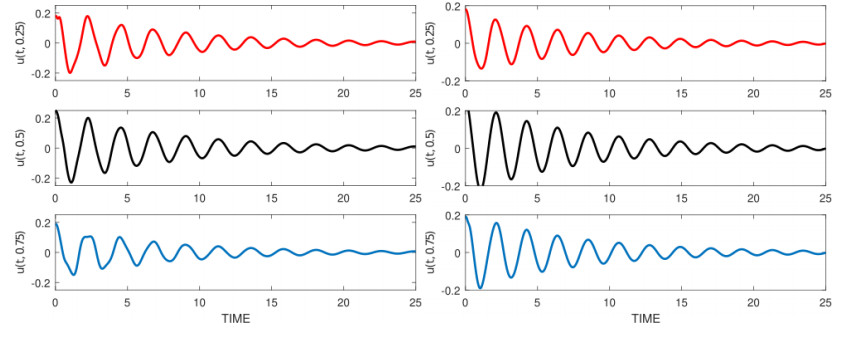









 DownLoad:
DownLoad:
